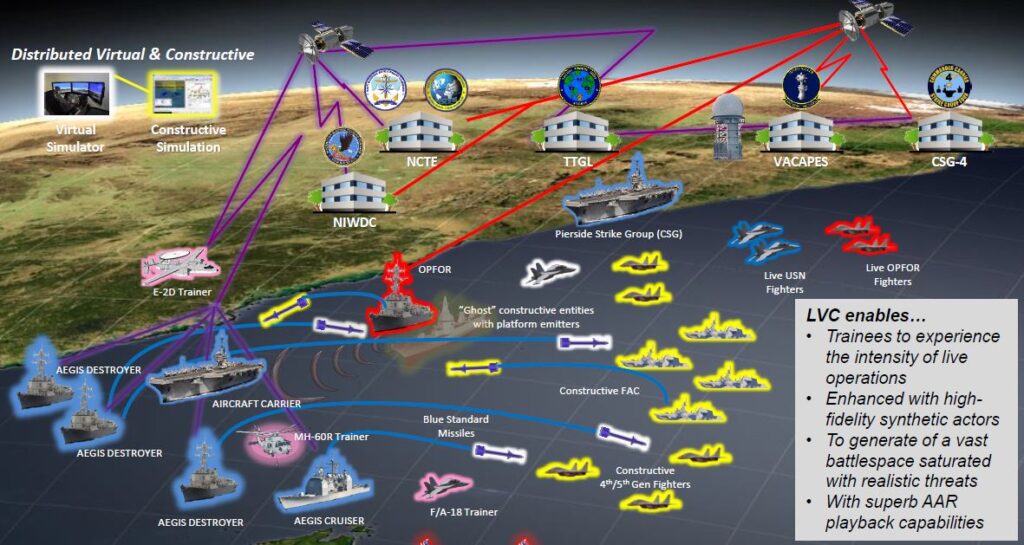
To meet the goal of digital transformation that seeks to eliminate onboard technical assists to ships by 2030 and advance the Navy’s training capabilities, Naval Surface Warfare Center, Port Hueneme Division has connected to the Navy Continuous Training Environment (NCTE).
Connectivity with NCTE enables warfighters to conduct live virtual constructive (LVC) training with live and synthetic systems around the globe. NSWC Corona Division in Corona, California, develops, manages, operates and maintains the NCTE on behalf of Commander, U.S. Fleet Forces Command and Commander, Pacific Fleet.
The NCTE consists of networks, simulations, simulation routing equipment, data translation devices and live training range systems used together to create a realistic LVC training environment.
“The ability to properly train or conduct training on a simulated threat that has the actual capability of the real threat, provides us with some knowledge of what our weapons can and cannot do,” said William Gieri, NSWC PHD Surface Warfare Engineering Facility (SWEF) manager. “It also provides training to fleet operations on what its people can expect in terms of how our systems would react to various threats.”
NCTE enables sailors to experience an integrated and secure training environment that can generate a variety of situations that might not be available in a live exercise but should be expected at sea, including scenarios with multiple ships and aircraft, according to Gieri.
“Instead of having real-life aircraft like commercial airlines, we can put simulated aircraft up there flying commercial routes and also aircraft from hostile countries that gives operators on the ship a much more realistic threat environment they’re more likely to encounter in various areas of the world they couldn’t otherwise experience in a sterile fleet environment or in an ocean where they don’t have aircraft routes,” Gieri said.
Gieri said he saw the tremendous potential to improve the command’s capabilities by connecting to NCTE. While NCTE was developed specifically for conducting fleet training, the command is exploring options to support events such as Combat Systems Ship Qualification Trials (CSSQT) and Combat System Assessment Team (CSAT) events using the NCTE capability.
“With the CSSQT events that we conduct, we can’t always provide real-world threats to the ships conducting them, so we are exploring using the NCTE and its capabilities to augment physical targets that we throw at the ships,” Gieri said.
Recently, USS Fitzgerald (DDG 62) was the first ship to visit NSWC PHD that participated in the Single Ship Synthetic Training, using NCTE to develop and deliver a complex scenario of multiple anti-ship cruise missile vignettes to help DDG 62’s training requirements.
And, the Navy recently used NCTE during the Large-Scale Exercise (LSE) 2021 to execute LVC events with forces from across the United States Fleet Forces Command, U.S. Pacific Fleet, and U.S. Naval Forces Europe-Africa. LSE 2021 was a globally integrated exercise that spanned multiple fleets across 17 different time zones connected using NCTE — executing new warfighting concepts and technology.
NSWC PHD’s use of NCTE is in the early stages, according to Gieri, and the team is learning what its full potential is and the different ways it can be used in training the warfighter and supporting the fleet.
“If you do the crawl, walk and run phase, you can throw simple threats at somebody, and once they become proficient at simple threats, you can throw more complex scenarios at them — much like you’d expect in the real world,” Gieri said. “So, it gives them the ability to learn from past experiences and become more proficient than if they were in an actual hostile engagement.”
In addition to providing enhanced training, NCTE is a cost-effective way to conduct complex training scenarios.
Sailors can also learn, while in a LVC training environment, how to tell the difference between a threat and a non-threat, as well as see how current weapons and combat systems may react to a potential threat.
“You can also recreate past scenarios, with different combat system baselines, which NSWC PHD is working toward right now with virtual test beds in the SWEF, so you can have a crew sitting at a combat information center with a combat system it has on its ship and see what real ships are doing on the range and see how that crew would react,” Gieri said.
Kanoko Esheim, NSWC PHD LVC lead, worked alongside Gieri to connect SWEF to NCTE.
“By coupling NCTE integrating architecture with the other digital transformation initiatives that are underway, the command is determined to activate a modernized capability to enhance the toolkit and workforce development activities,” Esheim said.
Gieri added that his team is exploring different ways the Navy can use the NCTE.
“We are working toward that end right now,” Gieri said. “We haven’t gotten there yet, but that’s the next generation, which is how to bring a land-based test site and marry it with a ship at sea to look at different combat systems and evaluate older or future combat systems with the combat systems on a ship on a training range.”
While NCTE was developed primarily for fleet training purposes, NSWC PHD is also exploring options for using it to support CSATs and CSSQTs.
“We’re working on use cases [that outline the purpose and likely uses] and presenting them to Pacific Surface Fleet leadership to see if there’s any buy-in or if the leaders can support that,” Gieri said. “This first test with NCTE during a CSAT at the end of September will be a proof-of-concept to evaluate if NCTE can be used in a CSAT environment.”






